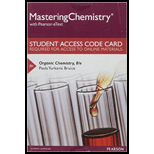
a.
Interpretation:
To write the products of the given reactions.
Concept introduction:
So many number of reactions are involved in the Carbonyl group. The carbonyl group is electrophilic nature, therefore it undergoes nucleophilic addition reactions.
For example carbonyl group reacts with Grignard reagent, it undergoes nucleophilic addition reactions and form unstable tetrahedral intermediate by the elimination of leaving group. Addition of hydrogen ion to the carbonyl carbon to form alkoxide ion. By the protonation of alkoxide ion forms alcohol.
b.
Interpretation:
To write the products of the given reactions.
Concept introduction:
So many number of reactions are involved in the Carbonyl group. The carbonyl group is electrophilic nature, therefore it undergoes nucleophilic addition reactions.
For example carbonyl group reacts with Grignard reagent, it undergoes nucleophilic addition reactions and form unstable tetrahedral intermediate by the elimination of leaving group. Addition of hydrogen ion to the carbonyl carbon to form alkoxide ion. By the protonation of alkoxide ion forms alcohol.
c.
Interpretation:
To write the products of the given reactions.
Concept introduction:
So many number of reactions are involved in the Carbonyl group. The carbonyl group is electrophilic nature, therefore it undergoes nucleophilic addition reactions.
For example carbonyl group reacts with Grignard reagent, it undergoes nucleophilic addition reactions and form unstable tetrahedral intermediate by the elimination of leaving group. Addition of hydrogen ion to the carbonyl carbon to form alkoxide ion. By the protonation of alkoxide ion forms alcohol.
d.
Interpretation:
To write the products of the given reactions.
Concept introduction:
So many number of reactions are involved in the Carbonyl group. The carbonyl group is electrophilic nature, therefore it undergoes nucleophilic addition reactions.
For example carbonyl group reacts with Grignard reagent, it undergoes nucleophilic addition reactions and form unstable tetrahedral intermediate by the elimination of leaving group. Addition of hydrogen ion to the carbonyl carbon to form alkoxide ion. By the protonation of alkoxide ion forms alcohol.
Want to see the full answer?
Check out a sample textbook solution
Chapter 16 Solutions
Organic Chemistry Study Guide and Solutions Manual, Books a la Carte Edition (8th Edition)
 Organic Chemistry: A Guided InquiryChemistryISBN:9780618974122Author:Andrei StraumanisPublisher:Cengage Learning
Organic Chemistry: A Guided InquiryChemistryISBN:9780618974122Author:Andrei StraumanisPublisher:Cengage Learning
